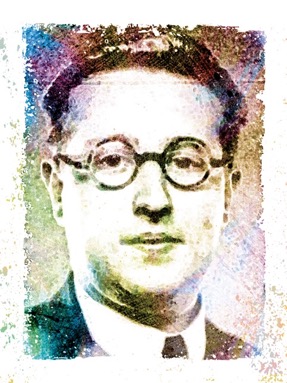
Zikmund Schul was born to an assimilated Jewish family in Chemnitz, Germany, on 11 January 1916, moving with his parents to Kassel, in Saxony, on 3 September 1928. Zikmund and his father departed from Germany, taking residence in Prague on 7 October 1933. At some point, he studied with Paul Hindemith at the Berlin Musikhochschule, returning to Prague in 1937 and continuing composition with Fidelio Finke and conducting with George Szell at the German music academy. A work from this period was very well received by a critic who wrote:
The highly accomplished composer, a student of the master class—inspired, incidentally, by Hindemith—is Siegmund Schul; who, in his rich imagination presents an extremely interesting work for the string sextet which stands on its own feet in terms of theme and style. (German newspaper, 9 June 1937.)
At this time he attended a Kapellmeister class and attended lectures by Alois Hába. Still in 1937, Schul set Isolde Kurz’s poem, ‘Die Nicht-Gewesenen’, followed by a song-cycle, Gesänge an Gott, which was broadcast live.
Further Prague compositions, through summer 1941, included a piano sonata, of which only the final movement, a fugue, survived. A flute and piano sonata has not been found, nor a liturgical setting of the Mogen owaus Friday night prayer. During his Prague years, Zikmund became closer to his Judaism and was friendly with the Lieben family. Evidently Rabbi Lieben, of the Altneuschul, encouraged Schul to study Kabbala as well as synagogue songs. With the encouragement of Rabbi Lieben, the Jewish community offered him the opportunity to work with an early 19th-century collection of recitatives and chants for use in synagogues, which is now located in the Jewish Music Research Center at the Hebrew University of Jerusalem in the National Library. During his years in Prague, he became friendly with Viktor Ullmann, who admired the work of the young man. Schul was transported to Terezín on 11 November 1941. During his imprisonment, he managed to continue composition and often met with Ullmann to discuss aspects of modern music.
The extent to which Schul selected Biblical texts for original compositions and arrangements, both instrumental and vocal, is quite remarkable. The Hebrew texts, selected from the Jewish liturgy, were clearly chosen to bolster hope rather than despair: ‘To build and to plant, to plow and to sow. And the wasteland will be worked and will no longer be desert’ (from Jeremiah, Isaiah, Samuel and Ezekiel). ‘Sound the great Shofar [ram’s horn] for our freedom…’ (When you come to the land). Several of Schul’s works in the ghetto included choral pieces, both original and arrangements. One of these works, written in summer 1941, Shield To Our Fathers, was scored for soprano, baritone, mixed choir and organ. It is not certain if it was performed.
Two of his Jewish instrumental pieces were on Ullmann’s second concert programme, ‘Young Composers in Terezín’, in his Studio für neue Musik series: Two Chassidic Dances for violin and cello and Divertimento Ebraica, written for Egon Ledeč’s string quartet. This work had evidently been admired when it was written and was then performed by the Ledeč-Quartett in 1942 and again in autumn 1943 at the above mentioned concert, and once more in mid-August 1944, this time as a memorial to Schul, who had suffered lengthily from tuberculosis and died in the camp on 2 June 1944. Although the quartet was ultimately lost, there was some critical evaluation. Ullmann wrote of it:
It is very clear that Schul turns, probably for the sake of tonality, to the variations of a Hebrew folksong (Divertimento Ebraico) in his Theresienstadt work for the string quartet. [Following its last performance he added] In the end it was supposedly Ledeč’s new quartet … in mind, which came up with a magically beautiful and excellently performed piece of Haydn for us, followed, finally, by Zikmund Schul’s interesting, well worked (and already well known) Divertimento Ebraico.
When Ullmann gathered Schul’s manuscripts together with his own as he was about to board the transport to Terezín, he was persuaded to entrust both his and Schul’s to the care of some friends who accompanied him to the train. Schul’s surviving works remained with Ullmann’s and many years later were deposited in the Goetheanum in Dornach, Switzerland. In 1993 Schul’s collection was sent to Israel. After Schul’s death Viktor Ullmann wrote an article about Zikmund’s music, sharing something of their conversations:
In the last years he [Schul] liked to discuss all the problems of the new music, questions of form and tonality, their reshaping and breaking up, questions of style, aesthetic, the current view of the world and many details pertaining to some of his works in progress … was thus getting a rare insight into the artistic development of this personality whose true calling was music… I am not using the commonplace phrase of ‘In Memoriam’ when I maintain that he was fully justified in saying, just before he died: ‘What a pity I have come to this’… And it was the truth. (Viktor Ullmann, Theresienstadt, June 1944)
Schul, himself a violist, completed his Duo for Violin and Viola on 28 February 1943. Of his compositions written in Terezín that survived, the Duo is perhaps his major work. Unfortunately, the first 74 bars of the opening movement are missing from the manuscript. The remaining 60 bars, nearly half the movement, are retained.
By David Bloch

Recent Comments